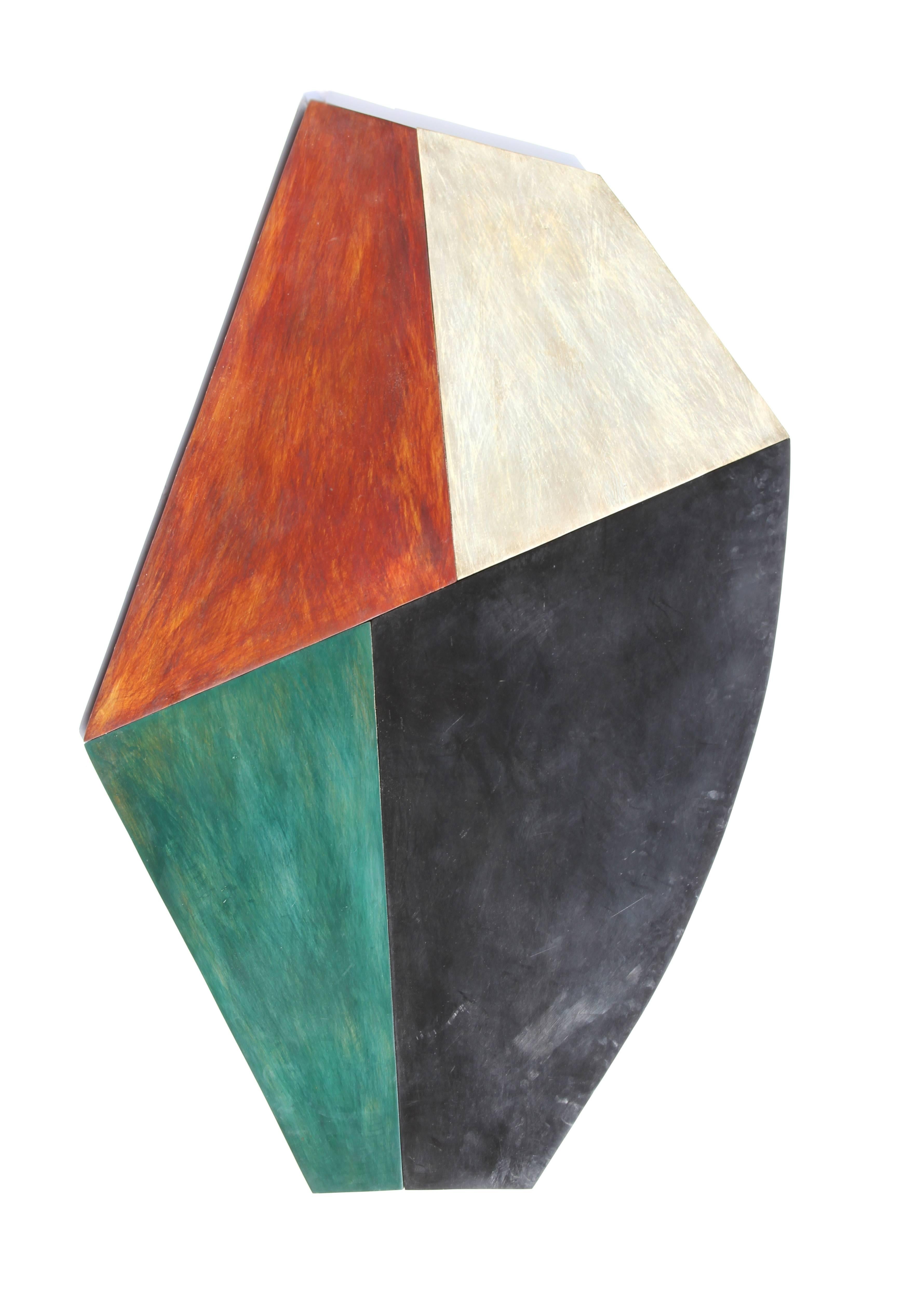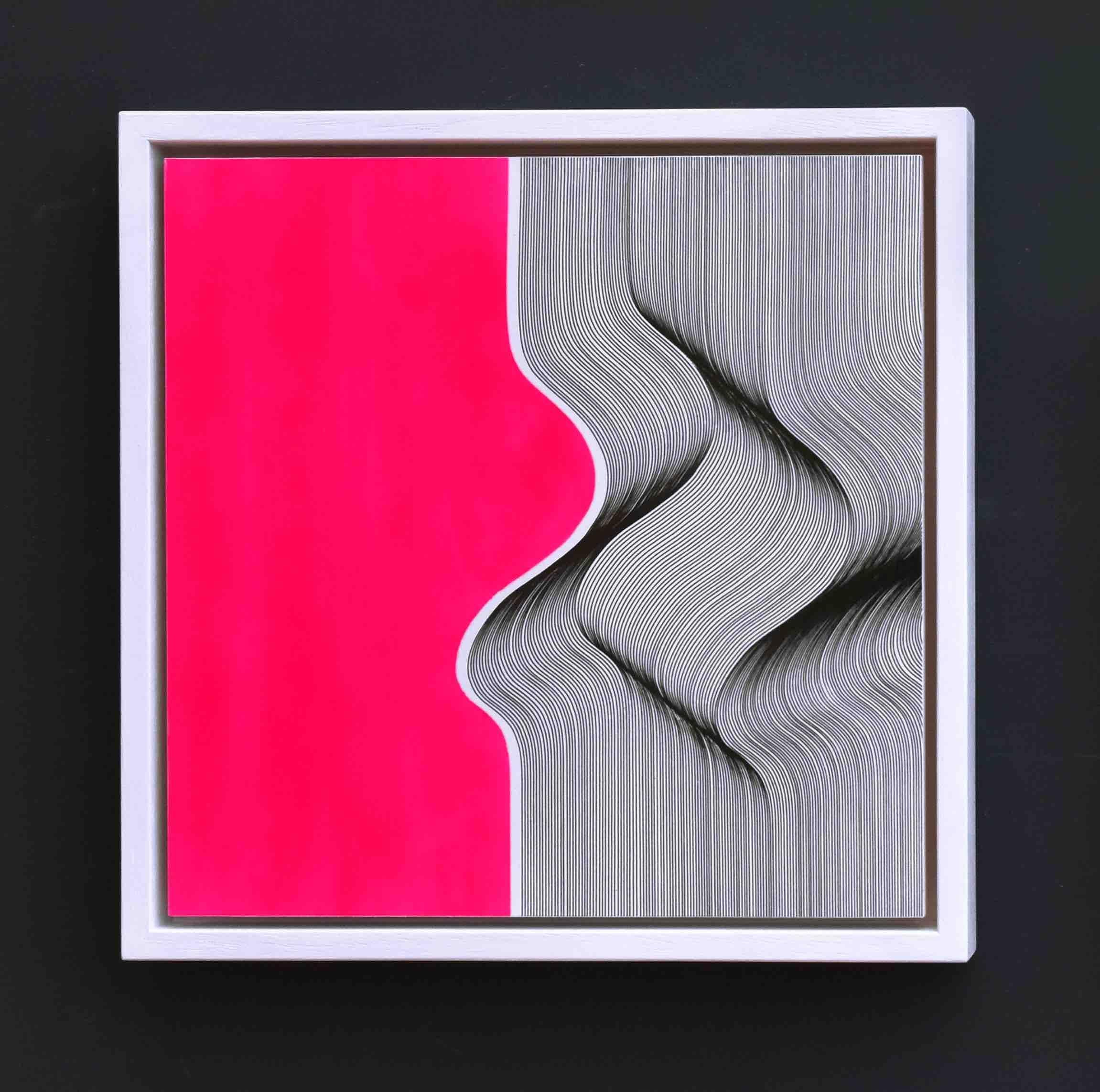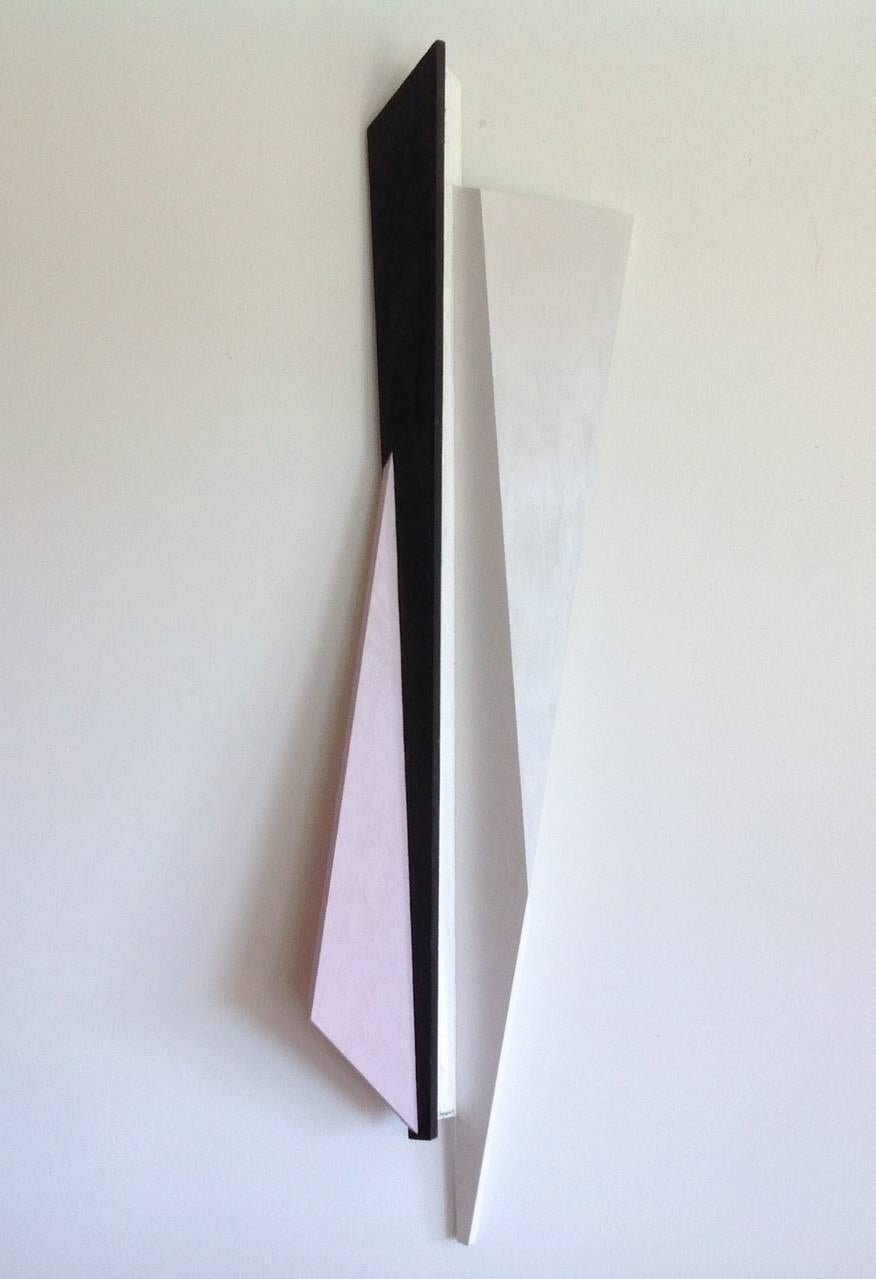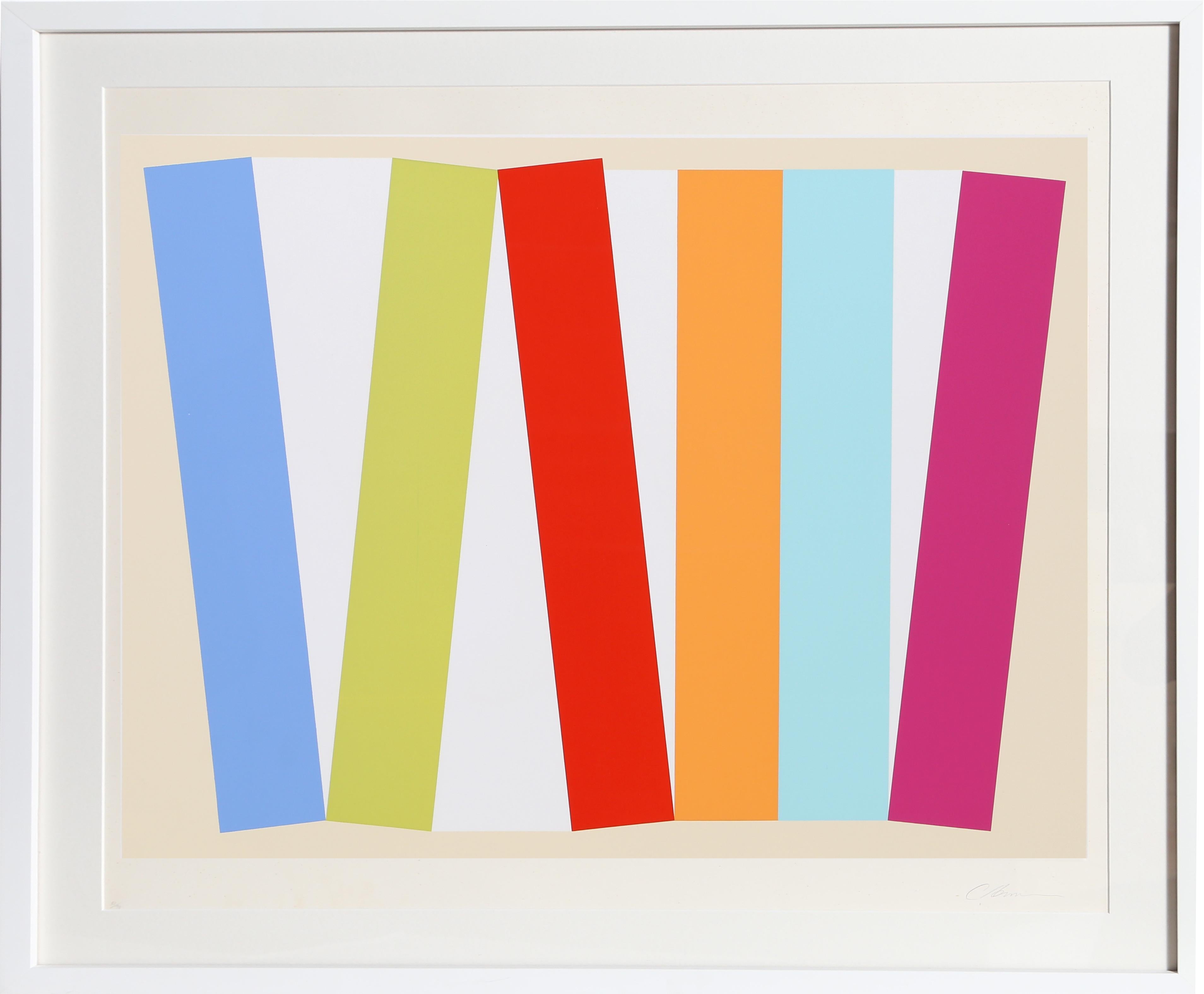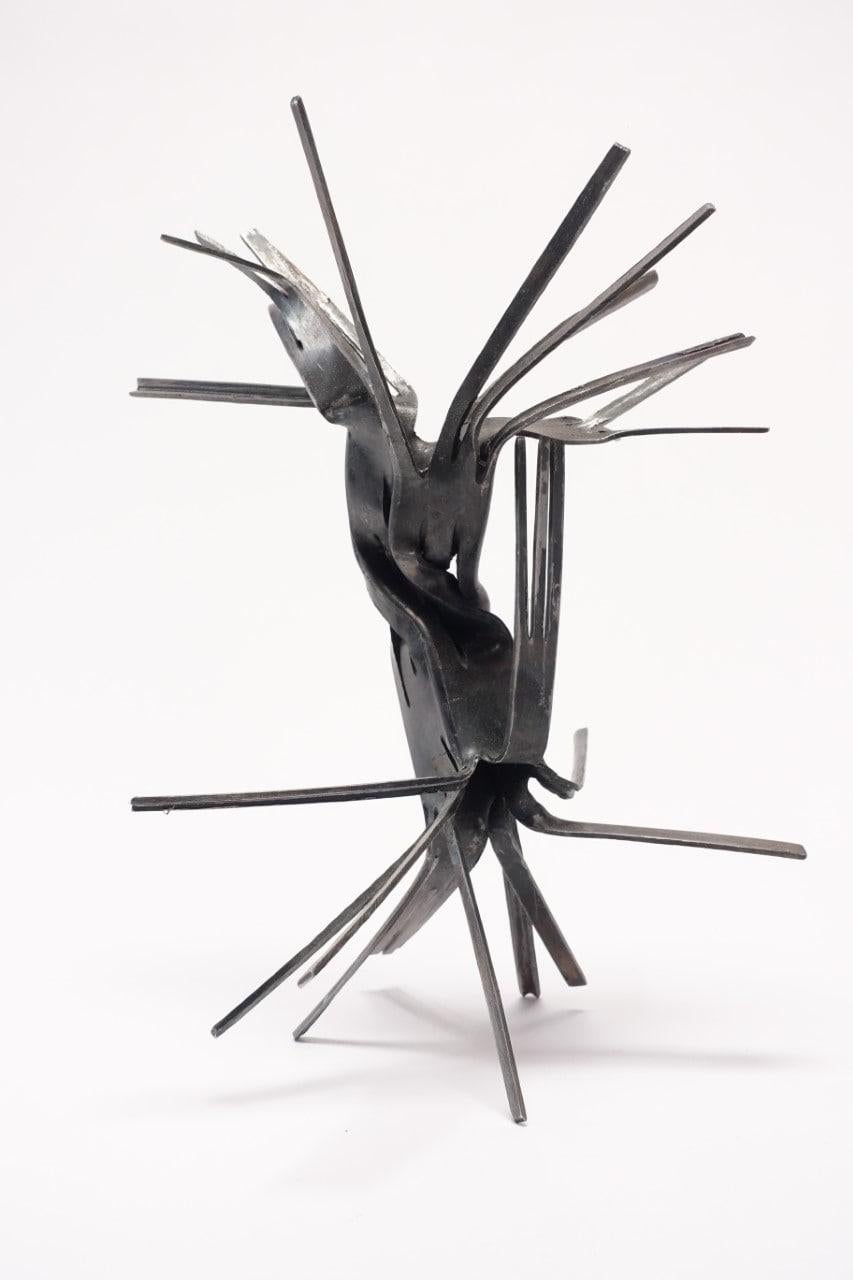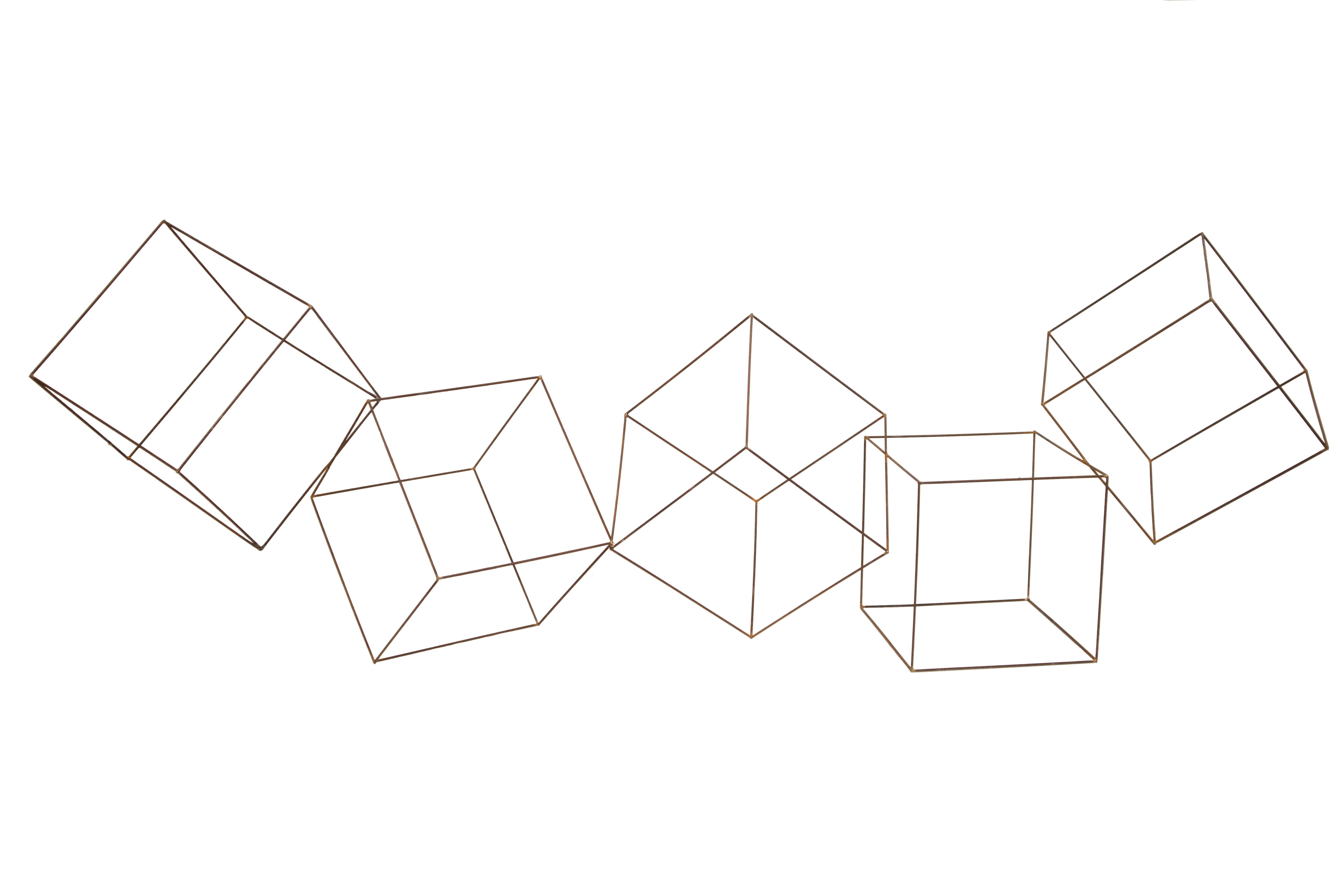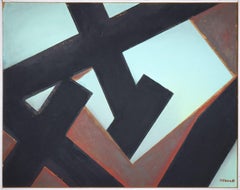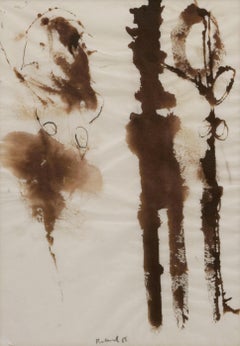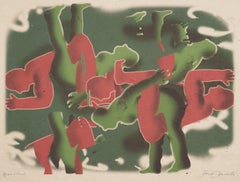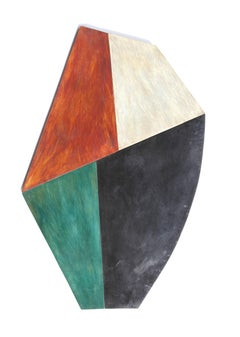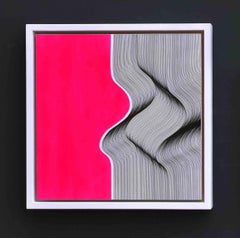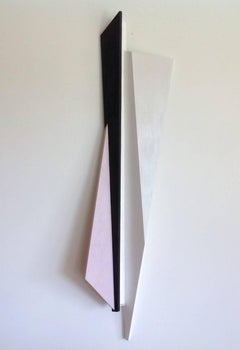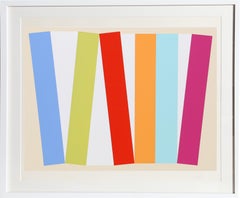Items Similar to Untitled / - Dancing Sculpture -
Want more images or videos?
Request additional images or videos from the seller
1 of 13
Gerlinde BeckUntitled / - Dancing Sculpture -
$361.35
$451.6920% Off
£270.95
£338.6920% Off
€304
€38020% Off
CA$504.22
CA$630.2820% Off
A$545.93
A$682.4120% Off
CHF 290.24
CHF 362.8020% Off
MX$6,584.25
MX$8,230.3120% Off
NOK 3,649.98
NOK 4,562.4720% Off
SEK 3,402.82
SEK 4,253.5320% Off
DKK 2,315.90
DKK 2,894.8820% Off
About the Item
Gerlinde Beck (1930 Stuttgart-Cannstatt - 2006 Mühlacker-Großglattbach), Untitled, 1973. Series of four serigraphs, 29.8 cm x 29.8 cm, each signed in lead on the front and numbered on the reverse. Sheet 1-3 no. 74/100, sheet 4 no. 48/100.
- Corners occasionally slightly bumped, minimal crease, otherwise in very good condition
- Dancing Sculpture -
In this series of images, Gerlinde Beck uses printmaking to bring a "dancing sculpture" to life, intensifying the sculptural tension and illustrating her understanding of the sculpture as dynamic. A conically cut cube towers above the picture format and floats on a fragile, multilayered substructure that converges with the cube at one point. A steel girder-like plate penetrates this formation, serving as both the foundation and an element of the sculpture itself. The shiny, silver background blends with the color of the dancing sculpture, creating the impression of a metallic arrangement.
"At the time, my work explored the aspect of the illusory. It is a play between two- and three-dimensional thinking."
Gerlinde Beck
About the artist
Gerlinde Beck studied at the Stuttgart Academy of Arts from 1949 to 1956 under Karl Hils, Peter Otto Heim, Gerhard Gollwitzer, and Willi Baumeister. She also trained as a precision sheet metal worker. In 1953, she took her first trip to Paris, where she encountered Henry Moore's sculptures and found inspiration in African art. In 1956, she married musician Hans-Peter Beck. That same year, she and Wolfgang Reiner founded a screen printing company that produced prints for Ida Kerkovius and Fritz Winter. After briefly working as a design teacher at an industrial company in Stuttgart in 1958, Gerlinde Beck worked as a freelance artist. From the 1960s onward, she was one of the leading sculptors of her generation in Germany. Starting in 1965, she created graphic works as well as sculptures. In 1968, the Kunsthalle Mannheim organized an exhibition of her art, and in 1969, the Wilhelm-Lehmbruck-Museum in Duisburg did the same. These exhibitions brought Gerlinde Beck international recognition. In 1974, her major work, "Klangstraße," was performed for the first time. In 1977, the Museum am Ostwall in Dortmund held a major retrospective of her art. This was followed by numerous public commissions. In 1984, she received the Federal Cross of Merit, and in 1989, she was awarded a professorship. In 1996, she founded the Gerlinde Beck Foundation at Schloss Dätzingen in Grafenau.
Through her light fugues, sound sculptures, sound spaces, and spatial choreographies, as well as her memory and foreboding images, she expanded the boundaries of sculpture.
"When my critics say I'm taking things to extremes, they're right. But I'm not turning the laws of physics on their head."
Gerlinde Beck
GERMAN VERSION
Gerlinde Beck (1930 Stuttgart-Cannstatt - 2006 Mühlacker-Großglattbach), Ohne Titel, 1973. Folge von vier Serigraphien, 29,8 cm x 29,8 cm, jeweils auf der Vorderseite in Blei signiert und rückseitig nummeriert. Blatt 1-3 Nr. 74/100, Blatt 4 Nr. 48/100.
- Ecken mitunter leicht bestoßen, minimale Knickspur, ansonsten in sehr gutem Zustand
- Tanzende Skulptur -
In der Abfolge der Bilder veranschaulicht die Serie eine ‚tanzende Skulptur‘, womit Gerlinde Beck die von ihr stets dynamisch verstandene Skulptur mit Hilfe der Druckgrafik in Bewegung versetzt und damit die skulpturale Spannung zuspitzt. Ein das Bildformat überragender konisch geschnittener Kubus schwebt auf einem fragilen mehrgliedrigeren Unterbau, der an einer Stelle mit dem Kubus zusammenläuft. Dabei wird diese Figuration von einer stahlträgerartigen Platte durchdrungen, die gleichermaßen das Fundament wie ein Element der Skulptur selbst ist. Der glänzende Silberton des Hintergrundes schließt sich farblich mit dem tanzenden Gebilde zusammen, so dass der Eindruck eines metallenen Arrangements evoziert wird.
„Meine Arbeiten untersuchten zu jener Zeit den Aspekt des Illusionären. Es ist ein Spiel zwischen zwei- und dreidimensionalem Denken."
Gerlinde Beck
zur Künstlerin
Gerlinde Beck studierte von 1949 bis 1956 an der Stuttgarter Akademie der Künste bei Karl Hils, Peter Otto Heim, Gerhard Gollwitzer und Willi Baumeister. Zusätzlich absolvierte sie eine Ausbildung als Feinblechner. 1953 erfolgte die erste Parisreise, auf der sie die Skulpturen Henry Moores für sich entdeckte und von afrikanischer Kunst inspiriert wurde. 1956 heiratete sie den Musiker Hans-Peter Beck und gründete im selben Jahr zusammen mit Wolfgang Reiner eine Siebdruckerei, in der Drucke für Ida Kerkovius und Fritz Winter hergestellt wurden. Nach einer kurzen Tätigkeit als Lehrerin für Formgestaltung in einem Stuttgarter Industriebetrieb, 1958, war Gelinde Beck als freischaffende Künstlerin tätig. Seit den 60er Jahren gehörte sie zu den führenden Bildhauern ihrer Generation in Deutschland. Ab 1965 schuf sie neben Skulpturen auch grafische Werke. Die Kunsthalle Mannheim veranstaltet 1968 und das Wilhelm-Lehmbruck-Museum in Duisburg 1969 eine Werkschau ihrer Kunst, was Gerlinde Beck auch internationale Bekanntschaft verschaffte. 1974 wird ihr Hauptwerk, die „Klangstraße“, zum ersten Mal ‚aufgeführt‘. 1977 fand eine große Retrospektive ihrer Kunst im Museum am Ostwall in Dortmund statt. Es folgten zahlreiche öffentliche Aufträge. 1984 wurde ihr das Bundesverdienstkreuz und 1989 der Professorentitel verliehen. 1996 gründete die Künstlerin die Gerlinde-Beck-Stiftung im Schloss Dätzingen in Grafenau.
Mit ihren Lichtfugen, Klangskulpturen, Klangräume, Raumchoreographien, Erinnerungs- und Ahnungsbilder erweiterte die die Grenzen der Bildhauerei.
„Wenn meine Kritiker sagen, ich würde die Sache auf die Spitze treiben, haben sie recht. Dass ich aber die physikalischen Gesetze auf den Kopf stelle, ist nicht der Fall.“
Gerlinde Beck
- Creator:Gerlinde Beck (1930 - 2006, German)
- Dimensions:Height: 11.74 in (29.8 cm)Width: 11.74 in (29.8 cm)Depth: 0.4 in (1 cm)
- Medium:
- Movement & Style:
- Period:
- Condition:
- Gallery Location:Berlin, DE
- Reference Number:1stDibs: LU2438216499942
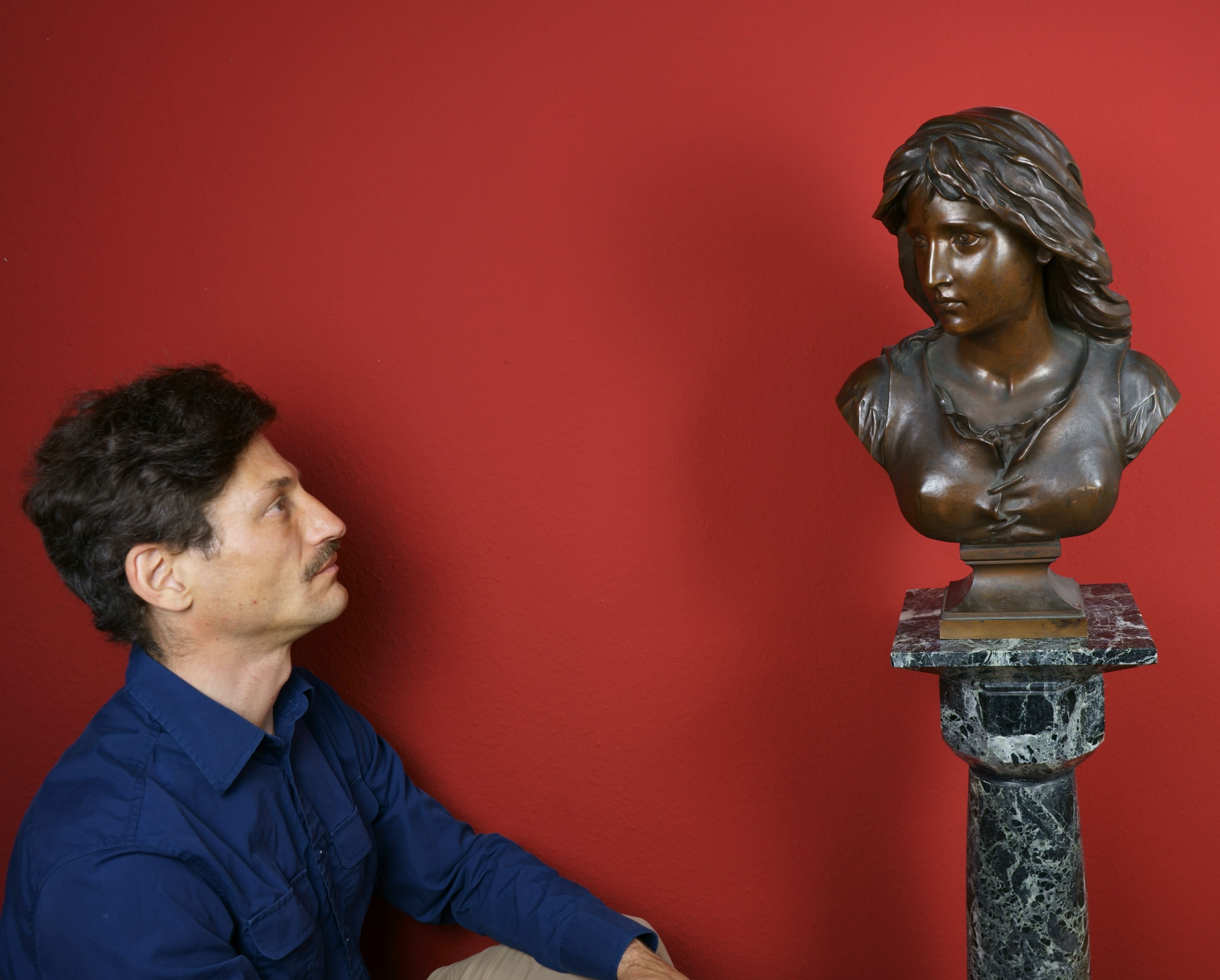
About the Seller
5.0
Vetted Professional Seller
Every seller passes strict standards for authenticity and reliability
Established in 2014
1stDibs seller since 2023
22 sales on 1stDibs
- ShippingRetrieving quote...Shipping from: Berlin, Germany
- Return Policy
More From This Seller
View AllTectonic Tension / - Archetypes of Painting -
Located in Berlin, DE
Jürgen Möbius (*1939 Großenhain), Tectonic Tension. Oil on hardboard, 47.5 x 60 cm, 49 x 61.5 cm (frame), signed lower right "Möbius" and dated "[19]81".
- Upper left corner with a small chip, light scratches and a little rubbed in places. Provisional gallery frame with traces of use.
- Archetypes of Painting -
About the artwork
The form structure in front of the eye is overlapped by the frame. Thus, the frame does not open up a space in which something is presented, but rather shows the seemingly arbitrary section of a comprehensive context that cannot be framed as such.
We see forms that stand in a structure of tension with each other, whereby the individual black and brown forms, which continue almost endlessly beyond the frame, already show a tension in themselves, since they are not only forms, but also surfaces - form surfaces, while the light blue surface ground is at the same time forms that appear as surface forms. The formed surfaces and surface forms are nested within each other and form a structure that encompasses all elements.
The angular arrangement of the black and brown shaped surfaces gives the structure a tectonic character. The tension is thus heightened to the point of paradox, since the black shape at the front is overlapped by the brown shape at the bottom in the center of the picture, which would be impossible in real space. It is precisely through this "paradox" that Möbius demonstrates that the paradoxical is reality within painting. It is, so to speak, the most original possibility of painting, which distinguishes it from the other arts. In combination with the tectonic formations, Jürgen Möbius creates an archaic primordial painting, which, however, should not be confused with the autonomous color and form cosmos of Suprematism à la Kasimir Malevich. Instead of homogeneous, perfectly colored forms, here the colors are deliberately applied unevenly, and the light blue is mixed with the brown in a manner determined by the brushstroke. At the edges of the surface forms, the uneven application of paint allows the wood of the unprimed hardboard to show through. In this way, Möbius illustrates that we are dealing with a painting that has been created by an act of painting - an act, however, that takes hold of the original principles of painting and thus realizes painting as such.
About the artist
From 1959 to 1965 Jürgen Möbius studied painting at the University Institute for Art and Work Education in Mainz. He also studied philosophy and art history at the University of Mainz. Afterwards he worked as a freelance artist in Mainz.
At first, Möbius created material reliefs and installations, then, around 1974, he turned increasingly to conceptual art and added cinematic means. During this phase he wrote the manifesto-like essay "Principles of Supranatural Landscape" (1979).
From 1981 on, Möbius concentrated on painting and searched for artistic ways to "treat intellectual and sensual perception equally in the fusion of representational and abstract pictorial elements" (Wolfgang Zemter). He found inspiration on his study trips to Thailand and Sri Lanka.
"The pure painting of Jürgen Möbius flows through us as a timeless expression of memory and energy, ploughing our perception and bringing us the happiness of seeing authentic, immovable form.
- Philippe Büttner
Selection of solo exhibitions
1969 Galerie Würzner, Düsseldorf / Galerie Gurlitt, Mainz
1972 Städtische Galerie, Mainz
1973 Galerie Schloss Ringenberg Rathaus, Kleve
1974 Röderhausmuseum, Wuppertal
1976 Galerie Glasing, Osnabrück / Städtische Galerie, Herne
1977, 1997, 2004 Märkisches Museum, Witten
1979 Studio M, Bamberg / Staatstheater, Darmstadt
1980 Galerie Stolànovà, Wiesbaden / Mittelrheinmuseum, Koblenz
1982 Galerie Dornhöfer, Mainz
1984 Galerie Neumühle, Schlangenbad
1985 Landesmuseum, Mainz / Kunstverein, Ludwigshafen / Nassauischer Kunstverein, Wiesbaden
1986 Museum, Bochum / Galerie der Stadt Iserlohn
1987, 1990 Galerie Klaus Kiefer, Essen
1987, 2000 Galerie Ulrike Buschlinger, Wiesbaden
1988 Kunsthalle Darmstadt
1988, 1992, 1996, 1999 Galerie Leonhard, Basel
1992, 2002 Galerie Zulauf, Freisheim
1994 Galerie Remy, Vallendar
1995 Sendezentrum des Zweiten Deutschen Fernsehens, Mainz
2001 Collegium oecumenicum, Bamberg / MVB Forum für Kultur und Wirtschaft, Mainz
2006 Adam Gallery, London
Selection of group exhibitions
1969 ‘International Graphic Arts’, Galerie Dalléas Bordeaux, Paris
1975 ‘Deutscher Künstler-Bund’, Dortmund
1979 ‘Man and man’s Images’, Märkisches Museum Witten
1980 ‘Love-Dokuments of our Time’, Art Hall Darmstadt and Art Association Hannover
1982 ‘Work - Progress – Position’, Nassau Art Association Wiesbaden
1983 ‘Principle Hope – Utopic Aspects in Art and Culture of the 20th Century’, Museum Bochum
1986 ‘Selfportraits’, Gallery Klaus Kiefer Essen
1987 ‘The Dying and Death’, Gallery Klaus Kiefer Essen
1989 ‘Where are You, Revolution – Freedom, Liberty, Egality, Fraternity to-day’, Museum Bochum 1990 ‘Flight – a Problem within the Memory of Man’, Kunsthalle Darmstadt ‘Art and War 1939 – 89’, House of Cultures Berlin
1991 ‘Material and Form’, Pillnitz Castle Dresden and Pfalz Gallery Kaiserslautern
1995 20 Years Exhibitions, Chrämerhuus Langenthal, Schweiz
1998 ‘Works on Paper’, Klaus Kiefer Gallery Essen
2000 ‘Acquisitions 1900 – 2000’, Mittelrhein-Museum Koblenz
2001 ‘Strange Pictures’, Klaus Kiefer Gallery Essen
2002 ‘10 Years Buschlinger Gallery’, Buschlinger Gallery Wiesbaden
2004 ‘Eternal Space – Pictures and Sculptures’, Dome of Bamberg
2005 Art Fair Chicago, Adam Gallery, London
Selected Bibliography
Mittelrheinisches Landesmuseum (Hrsg.): Jürgen Möbius - Neue Bilder, Mainz 1985.
Kunstverein Darmstadt (Hrsg.): Jürgen Möbius. Bilder 1985 - 1988. Kunsthalle Darmstadt, 26. Juni - 14. August 1988. Red. Dorit Marhenke, Lyrik Marcus Schiltenwolf, Düsseldorf 1988.
Gabriele Prusko (Hrsg.): Jürgen Möbius. Mit Texten von Philippe Büttner und Ralph Mieritz, Basel 1992.
Wolfgang Zemter (Hrsg.): Jürgen Möbius - Aktuelle Arbeiten. Märkisches Museum der Stadt Witten, Bönen 1999.
Wolfgang Zemter (Hrsg.): Jürgen Möbius. Flieger in meinem Zimmer und Beruhigte Zone, Bönen 2004.
Dama Gallery...
Category
1980s Abstract Abstract Paintings
Materials
Oil
$1,331 Sale Price
20% Off
Untitled / - The archaism of nature -
Located in Berlin, DE
Jorge Machold (1940 Chemnitz - 2015 Berlin), Untitled, 1973. Color etching, 41.5 x 29.2 cm (plate size), 49.5 cm x 39.5 cm (sheet size), signed lower right in lead “J.[orge] Machold”...
Category
1970s Abstract Abstract Prints
Materials
Paper
$209 Sale Price
20% Off
Untitled / - Association -
Located in Berlin, DE
Detlef Baltrock (*1954 Stuttgart), Untitled, 1985. Watercolor, 29.5 cm x 21 cm (visible dimensions), 41 cm x 32 cm (frame), signed “Baltrock” lower center and signed “[19]85”, label ...
Category
1980s Abstract Expressionist Abstract Drawings and Watercolors
Materials
Paper
$332 Sale Price
20% Off
Intertwined Figures - Complementary tension -
Located in Berlin, DE
Johanna Obermüller (*1938 Timișoara), Intertwined Figures, around 1985. Pigment print on Japanese paper, 25 cm x 33.5 cm (image), 29.8 cm x 42.5 cm (sheet dimensions), signed “Johann...
Category
1980s Contemporary Figurative Prints
Materials
Paper
Vegetative Form / - Grown Art -
Located in Berlin, DE
Paul Dierkes (1907 Cloppenburg - 1968 Berlin), Vegetative Form. Mahogany, 1958. 142 x 16 x 10 cm (sculpture), 21 x 17.5 cm (base), monogrammed "PD" on the reverse.
- Grown Art -
...
Category
1950s Post-War Abstract Sculptures
Materials
Mahogany
$3,328 Sale Price
20% Off
My treasure, my sanctuary / - A Tortured Treasure -
Located in Berlin, DE
Johannes Heisig (*1953 Leipzig), "My treasure, my sanctuary" - To the Christmas Oratorio by Johann Sebastian Bach. Lithograph on strong yellowish laid paper with watermark, 53 x 39.5...
Category
1980s Abstract Expressionist Figurative Prints
Materials
Lithograph
$361 Sale Price
20% Off
You May Also Like
Geometric (Dancing Gold Var.)
By Catherine Lee
Located in Long Island City, NY
Artist: Catherine Lee, American (1950 - )
Title: Geometric (Dancing Gold Var.)
Year: circa 1989
Medium: Welded Bronze and Steel Sculpture
Size: 57 x 35.5 x 3.5 in. (144.78 x 90.17 x ...
Category
1980s Abstract Geometric Abstract Sculptures
Materials
Bronze, Steel
Movement 2023 - geometric abstract painting
By Roberto Lucchetta
Located in New York, NY
This hand painted piece by Lucchetta is part of the op art series where he is able to catch movement with his unique technique. Lucchetta is challenging himself. His precise stable hand can be sometime mistaken to a work of a machine, a printer. But if you look close enough you are able to see that it is a work of a line master!!
This piece comes framed in a white wooden frame. The measurements of the work with the frame is 11/11".
Op art masters from the 20's century that are inspiration to Lucchetta's pieces are Victor Vasarely, Brigit Riley...
Category
2010s Abstract Geometric Abstract Paintings
Materials
Wood, Ink, Acrylic, Cardboard
How She Can Dance So Beautifully (Modern Minimalist Abstract Wall Sculpture)
By Dai Ban
Located in Hudson, NY
54 x 15 x 5.5 inches
carved precision board & Venetian plaster
This contemporary, abstract minimalist wall sculpture was made by Japanese artist, Dai Ban in 2017. The elegant minim...
Category
2010s Contemporary Abstract Sculptures
Materials
Plaster, Foam Board
Dance, Minimalist Geometric Abstract Screenprint by Charles Hinman
By Charles Hinman
Located in Long Island City, NY
Artist: Charles Hinman, American (1932 - )
Title: Dance
Year: 1972
Medium: Screenprint, signed and numbered in pencil
Edition: 150; AP XII
Image Size: 12 x 16 inches
Size: 14 x 18 in...
Category
1970s Abstract Geometric Abstract Prints
Materials
Screen
Flap Dancer : contemporary steel sculpture and home decor
Located in New York, NY
A beautiful contemporary sculpture by Susan Woods. This artwork would be a great addition to any location and a wonderful decor for your home or commercial space.
The sculpture is a...
Category
2010s Abstract Expressionist Abstract Sculptures
Materials
Steel
Baile De Cubos II - 21st Cent, Contemporary Art, Abstract Sculpture, Iron rods
By Lukas Ulmi
Located in Barcelona, Catalonia
Lukas Ulmi’s work unveils the hidden beauty of shapes taking stones, seemingly static forms, incomplete or meaningless objects and turning them into authentic sculptures where weight...
Category
21st Century and Contemporary Contemporary Abstract Sculptures
Materials
Iron
More Ways To Browse
Dancing Sculpture
Sound Sculpture
Shiny Sculpture
La Memoire Elementaire
Lee Krasner Poster
Louttre B
Manuel Felguerez Barra
Matisse Nuit De Noel
Merce Cunningham Poster
Miro Fondation Maeght
Miro Umbracle
Miro Verve
Motherwell Red Sea
Nemesio Antunez
Niki De St Phalle
Pablo Palazuelo On Sale
Paul Huxley
Phillip Anthony
